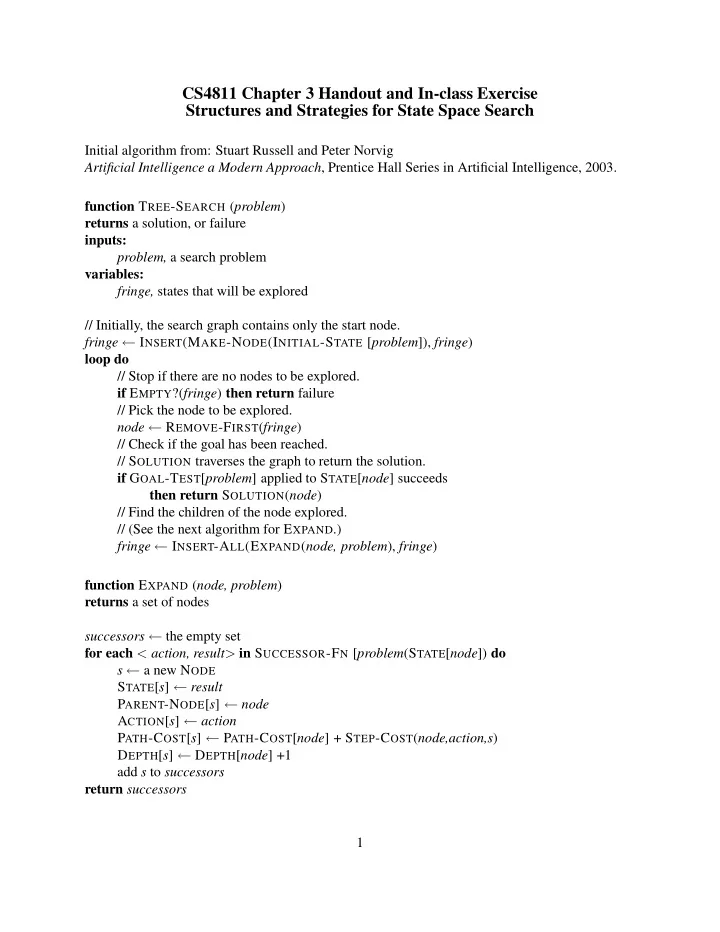

CS4811 Chapter 3 Handout and In-class Exercise Structures and Strategies for State Space Search Initial algorithm from: Stuart Russell and Peter Norvig Artificial Intelligence a Modern Approach , Prentice Hall Series in Artificial Intelligence, 2003. function T REE -S EARCH ( problem ) returns a solution, or failure inputs: problem, a search problem variables: fringe, states that will be explored // Initially, the search graph contains only the start node. fringe ← I NSERT (M AKE -N ODE (I NITIAL -S TATE [ problem ]), fringe ) loop do // Stop if there are no nodes to be explored. if E MPTY ?( fringe ) then return failure // Pick the node to be explored. node ← R EMOVE -F IRST ( fringe ) // Check if the goal has been reached. // S OLUTION traverses the graph to return the solution. if G OAL -T EST [ problem ] applied to S TATE [ node ] succeeds then return S OLUTION ( node ) // Find the children of the node explored. // (See the next algorithm for E XPAND .) fringe ← I NSERT -A LL (E XPAND ( node, problem ), fringe ) function E XPAND ( node, problem ) returns a set of nodes successors ← the empty set for each < action, result > in S UCCESSOR -F N [ problem (S TATE [ node ]) do s ← a new N ODE S TATE [ s ] ← result P ARENT -N ODE [ s ] ← node A CTION [ s ] ← action P ATH -C OST [ s ] ← P ATH -C OST [ node ] + S TEP -C OST ( node,action,s ) D EPTH [ s ] ← D EPTH [ node ] +1 add s to successors return successors 1
Now, we will change the tree search method into a graph search by renaming fringe to open , and adding a new list called closed . function G RAPH -S EARCH ( problem ) returns a solution, or failure inputs: problem, a search problem variables: open, states that will be explored closed, states that have already been explored // Initially, the search graph contains only the start node. open ← I NSERT (M AKE -N ODE (I NITIAL -S TATE [ problem ]), open ) loop do // Stop if there are no nodes to be explored. if E MPTY ?( open ) then return failure // Pick the node to be explored. node ← R EMOVE -F IRST ( open ) // Put the picked node in the closed list. closed ← I NSERT -A LL (node, closed ) // Check if the goal has been reached. // S OLUTION traverses the graph to return the solution. if G OAL -T EST [ problem ] applied to S TATE [ node ] succeeds then return S OLUTION ( node ) // Find the children of the node explored. // Discard children that are already in open or closed . // (I NSERT -N OT S EEN should take care of this.) // The E XPAND algorithm is the same. open ← I NSERT -N OT S EEN (E XPAND ( node, problem ), open ) Note that the G RAPH -S EARCH method outlined above is a generic search algorithm. The last line where the open list is updated controls the type of the search. For instance, if the new nodes are inserted to the beginning, then it is Depth First Search (DFS). If the new nodes are inserted to to the end, then it is Breadth First Search (BFS). If the open list is ordered with respect to a heuristic function, then it is heuristic search. 2
In class exercise A farmer wants to get his goat, wolf and cabbage to the other side of the river. His boat isn’t very big and can only carry him and either his goat, his wolf or his cabbage. Now . . . if he leaves the goat alone with the cabbage, the goat will gobble up the cabbage. If he leaves the wolf alone with the goat, the wolf will gobble up the goat. When the farmer is present, the goat and cabbage are safe from being gobbled up by their predators. How does the farmer manage to get everything safely to the other side of the river? Formulate this as a search problem. In other words, • Define what a state is. • Define the initial state and the goal state • Describe how to obtain the children of a state, i.e., define the S UCCESSOR -F N method. • Draw the full search tree with repeated nodes omitted. 3
Recommend
More recommend